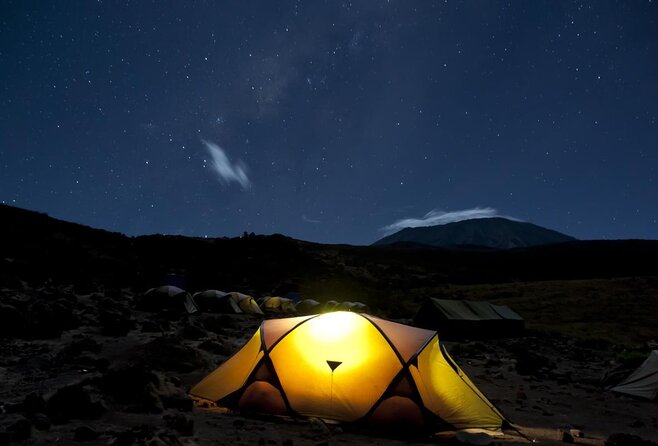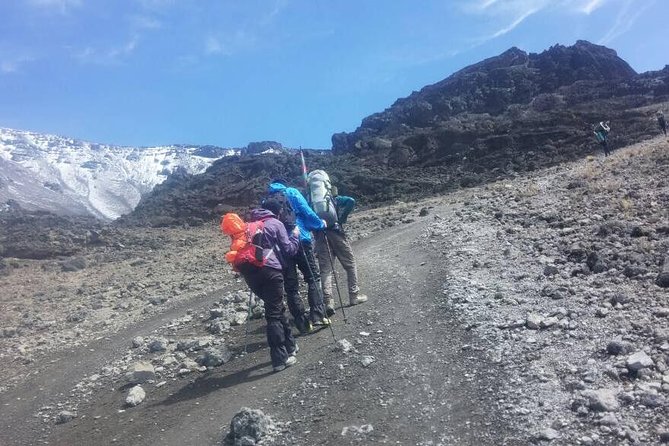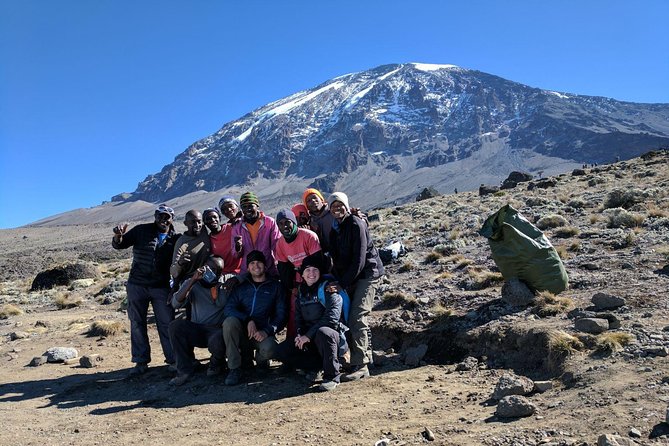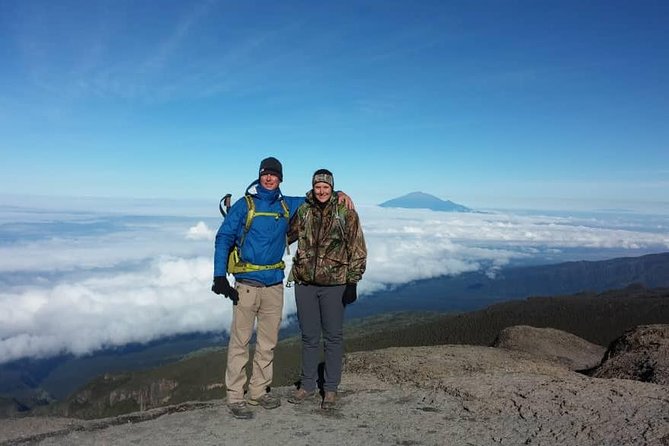Climbing Kilimanjaro is a bucket-list adventure for many outdoor enthusiasts. The 7-day Lemosho Route offers a less crowded and more gradual ascent, making it an appealing choice for trekkers seeking an unforgettable challenge. This route takes climbers through diverse ecosystems, from lush rainforests to striking alpine landscapes, offering breathtaking views and opportunities to encounter unique wildlife. With proper preparation and experienced guides, adventurers can push themselves to conquer the summit of Uhuru Peak at 5,895 meters. But the journey to the top is no easy feat – it requires physical fitness, mental fortitude, and the ability to adapt to the changing conditions on the mountain.
Good To Know

- The Lemosho route is a scenic, less-crowded path to the Kilimanjaro summit, taking 7 days to complete and offering a gradual ascent.
- Proper gear, physical training, and understanding of altitude sickness prevention are essential for a successful Kilimanjaro adventure.
- Packing for the trek includes essential items like a warm sleeping bag, waterproof layers, sturdy boots, and a daypack for daily essentials.
- Acclimating to the altitude is crucial, requiring gradual ascent, hydration, nutrient-dense meals, and rest to adjust to the changing oxygen levels.
- Overcoming challenges like altitude sickness, steep ascents, unpredictable weather, and fatigue requires experienced guides, quality gear, and determination.
Preparing for Your Kilimanjaro Adventure
Preparing for your Kilimanjaro adventure requires thoughtful planning and preparation.
First, you’ll need to ensure you have the proper gear, including hiking boots, layers of clothing, and trekking poles.
It’s also crucial to train for the physical demands of the hike, gradually building up your endurance and strength.
Plus, you’ll want to research altitude sickness prevention and familiarize yourself with the symptoms.
Proper hydration, pacing, and rest are key.
Finally, review the itinerary and be aware of the terrain and weather conditions you may encounter.
With the right mindset and preparation, you’ll be well on your way to an unforgettable Kilimanjaro experience.
You can also read our reviews of more tours and experiences in Moshi.
Understanding the Lemosho Route

The Lemosho route is one of the most scenic and less-crowded paths to the summit of Kilimanjaro.
It’s a longer and more challenging route, taking 7 days to complete, but rewards hikers with incredible views and a more gradual ascent that helps with acclimatization.
Some key features of the Lemosho route include:
- Diverse landscapes, from lush rainforests to alpine deserts and glaciers.
- Fewer crowds compared to other popular routes, providing a more immersive experience.
- A gradual ascent that increases the chances of successful summit and reduces altitude sickness.
- Stunning views of the Shira Plateau, Lava Tower, and Barranco Wall along the way.
The Lemosho route is an excellent choice for those seeking a more adventurous and less-traveled path to the top of Kilimanjaro.
Packing for the Trek

With the Lemosho route’s diverse landscapes and gradual ascent, hikers must pack carefully to ensure a comfortable and successful trek. A warm sleeping bag, waterproof layers, and sturdy hiking boots are essential.
Trekkers should also bring a daypack for carrying water, snacks, and extra clothes during the day. Sunscreen, sunglasses, and a wide-brimmed hat help protect from the sun’s intensity.
Personal medications, a water filtration system, and a power bank for charging devices are also recommended. Porters carry the bulk of the gear, but hikers must be prepared to carry their own daily essentials.
Acclimating to the Altitude

Acclimating to the altitude is crucial for a successful Kilimanjaro trek. The gradual ascent of the Lemosho route allows trekkers to slowly adjust to the decreasing oxygen levels.
This acclimatization process is essential to prevent altitude sickness and ensure a safe and enjoyable climb.
To help with this, climbers should:
- Drink plenty of water and stay hydrated.
- Avoid alcohol and caffeine, which can dehydrate the body.
- Eat high-calorie, nutrient-dense meals to fuel the body.
- Listen to their body and take rest breaks as needed.
Climbing Through the Diverse Landscapes

Majesty and wonder permeate the Lemosho route as it winds through Kilimanjaro’s diverse landscapes. Trekkers travel through lush, montane forests teeming with wildlife.
As they ascend, the scenery transforms to moorlands dotted with otherworldly senecio plants. Reaching the Shira Plateau, they’re rewarded with panoramic views of the mountain’s glaciated peaks.
The route then leads hikers through the stark, lunar-like landscape of the Barranco Valley before the final push to Uhuru Peak.
Throughout the journey, trekkers are awed by Kilimanjaro’s changing ecosystems and striking beauty. Each section of the Lemosho route offers a new perspective, making the climb a truly unforgettable experience.
Overcoming Challenges on the Mountain
Trekking Kilimanjaro’s Lemosho route isn’t without its challenges. Climbers must contend with high-altitude trekking, changes in terrain and weather, and physical exertion. However, with the right mindset and preparation, these obstacles can be overcome.
Some key challenges on the Lemosho route include:
-
Altitude sickness: Headaches, nausea, and fatigue are common at high elevations, requiring proper acclimatization.
-
Steep ascents: The trail features long, grueling uphill sections that test a climber’s endurance.
-
Unpredictable weather: Sudden storms, freezing temperatures, and strong winds can make the trek more arduous.
-
Exhaustion: The long days of hiking take a toll, making rest and proper nutrition crucial.
With experienced guides, quality gear, and a determined spirit, the Lemosho route can be conquered, rewarding climbers with the breathtaking views of Kilimanjaro’s summit.
Experiencing the Summit of Kilimanjaro

Reaching the summit of Kilimanjaro is the culmination of a challenging yet rewarding journey. Trekkers who make it to the top, at 5,895 meters (19,341 feet), are treated to breathtaking panoramic views and a profound sense of accomplishment.
The final ascent to Uhuru Peak is often the most grueling, with steep switchbacks and thin air testing even the most prepared climbers. However, the sense of joy and triumph upon reaching the summit makes the effort worthwhile.
Climbers can spend time at the top, taking in the stunning landscape and capturing unforgettable memories, before beginning the long descent back down the mountain.
The summit experience is the culmination of days spent overcoming challenges and immersing oneself in the awe-inspiring beauty of Kilimanjaro.
Reflecting on Your Accomplishment
Reflecting on one’s accomplishment after successfully summiting Kilimanjaro can be deeply rewarding. Reaching the top of Africa’s highest peak is a remarkable achievement that instills a profound sense of pride and personal growth.
The journey up Kilimanjaro demands incredible perseverance, physical endurance, and mental fortitude. Some key reflections to consider include:
-
Overcoming challenges: The trek tests one’s limits, but conquering those obstacles builds resilience and self-confidence.
-
Appreciating nature: The trek offers breathtaking vistas and a deeper connection with the natural world.
-
Teamwork and camaraderie: Summiting requires collaboration with guides and porters, fostering a spirit of unity and support.
-
Personal transformation: The experience can lead to a renewed outlook on life and a heightened sense of what’s truly important.
Frequently Asked Questions
What Is the Best Time of Year to Climb Kilimanjaro?
The best time to climb Kilimanjaro is typically during the dry seasons, from July to October and December to March. These periods offer the most favorable weather conditions and reduced chances of rainfall or snow on the mountain.
Can I Bring My Own Camping Gear Instead of Renting?
You can bring your own camping gear instead of renting, but it’s generally better to use the equipment provided. The tour company ensures the gear is appropriate and in good condition, which can make your climb more comfortable and worry-free.
How Often Do Groups Get Caught in Bad Weather on the Trek?
While bad weather is always a possibility in mountainous areas, reputable tour operators take precautions to minimize risks. Most Kilimanjaro treks proceed without major weather disruptions, though hikers should expect some changes in conditions during the multi-day climb.
What Is the Success Rate for Reaching the Summit on This Route?
The success rate for reaching the summit on the Lemosho route is generally high, with around 85-90% of climbers typically making it to the top. This route is considered one of the more successful options for Kilimanjaro expeditions.
Is There an Option to Have a Private Guide for the Climb?
Yes, the tour operator offers private guides for the climb. Travelers can opt for a private guide for an additional fee, which provides more personalized attention and a more customized experience during the trek.
The Sum Up
The Kilimanjaro Climbing 7 Days Lemosho Route offers an unforgettable challenge that rewards trekkers with stunning vistas and a profound sense of accomplishment. With proper preparation and an experienced guide, climbers can conquer the mighty Uhuru Peak, leaving them with memories that will last a lifetime. The gradual ascent and diverse ecosystems make this route a truly remarkable adventure for those seeking to challenge themselves on the roof of Africa.
More 7-Day Experiences in Moshi
More Tour Reviews in Moshi
Not for you? Here's more nearby things to do in Moshi we have reviewed
- Day Trip To Tarangire National Park
- Mountain Kilimanjaro Climbing 6 Days Machame Route
- 6 Days Rongai Route Climbing Mt.Kilimanjaro
- 7-Day Kilimanjaro Climb Machame Route
- 7-Days Tour Mount Kilimanjaro Trekking via Machame Route
- Kilimanjaro: Lemosho Route and Camping Safari
- 8 Days 7 Nights Private Lodge Safari
- 5 Days Comfort Safari in Tanzania
- 2 Days Lodge Safari.
- One Day Tanzania Safari – Tarangire or Arusha National Park
- Day Trip Lake Manyara
- Tanzania Family Safari Adventure
